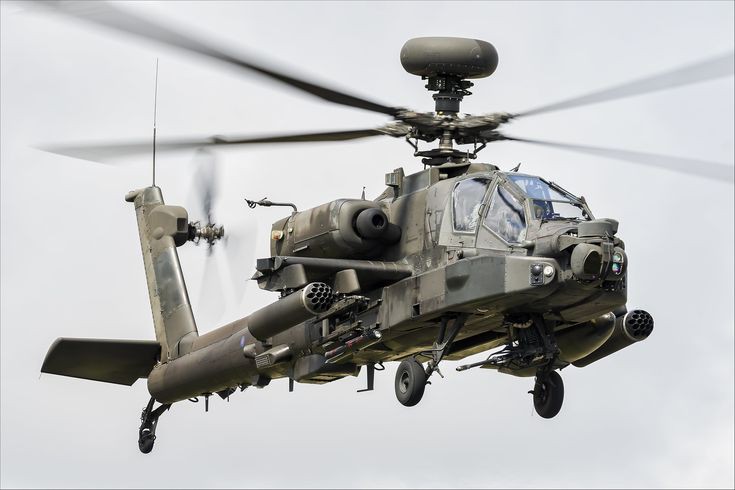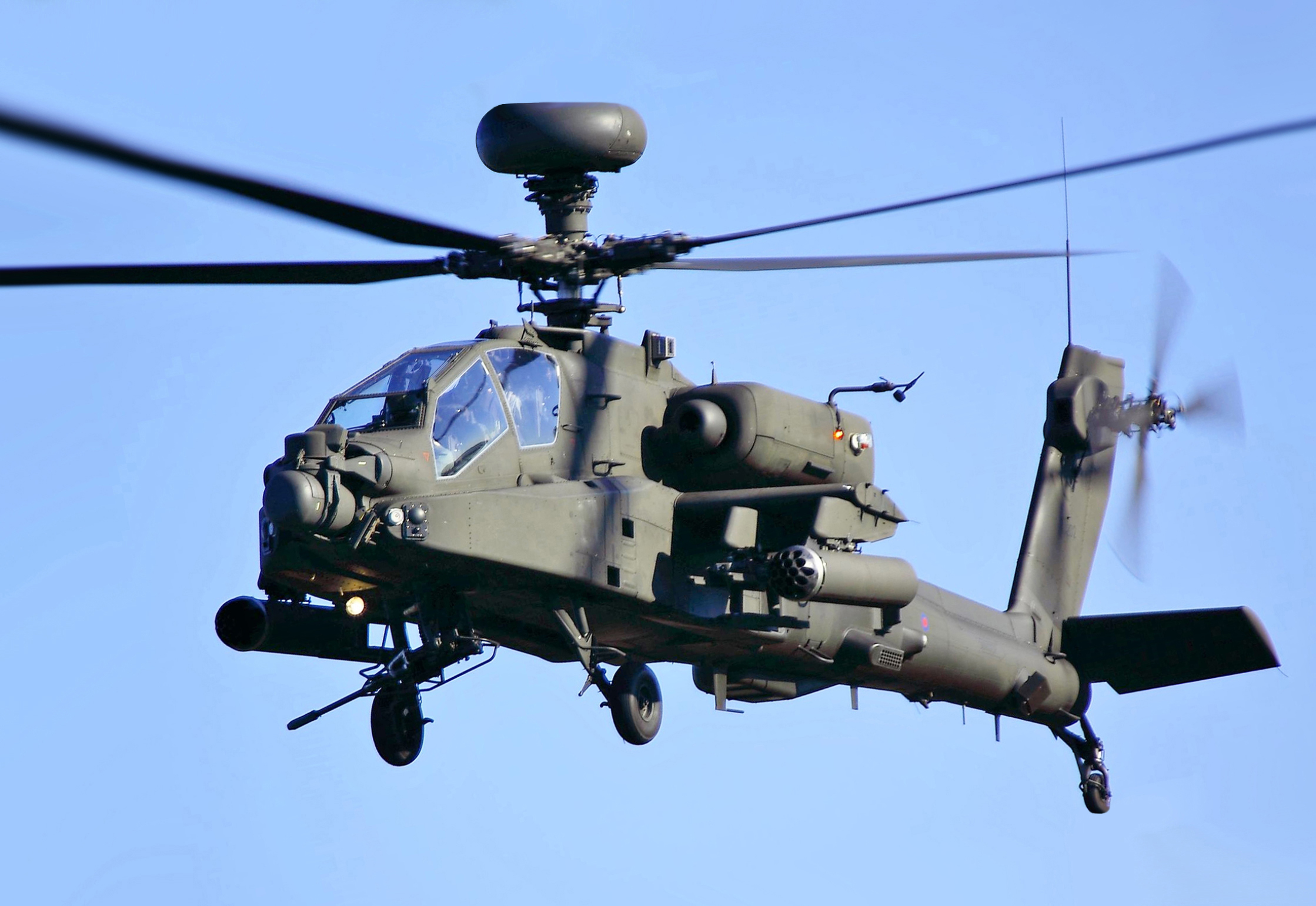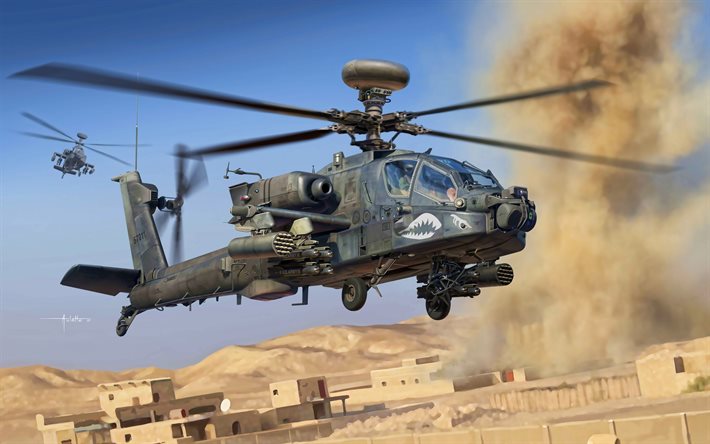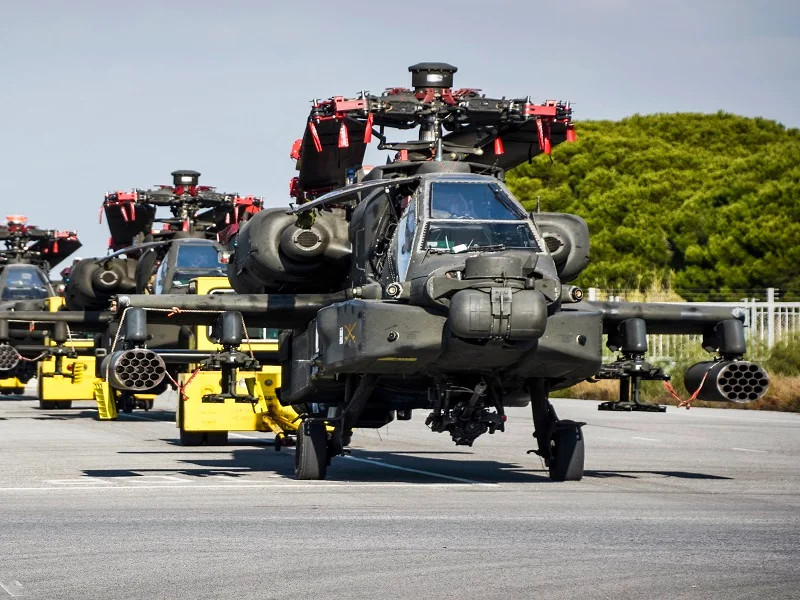
Today, there are seven most powerful anti-tank ωєαρσиs in the world, and attack helicopters can be ranked first on the list. Attack Helicopters are known as Tank Destroyers, they are equipped with dєadly ωєαρσиs such as Anti-tank Guided Missiles, which can very easily destroy any Battle Tank in seconds.
The AH-64 Apache is a heavily armed attack helicopter primarily used by the United States Army and various international operators. It is known for its capabilities in close air support, anti-armor operations, and reconnaissance missions. Here are some key capabilities of the AH-64 Apache gunship:
- Armament: The Apache is equipped with a 30mm M230 Chain Gun mounted under its nose, capable of firing various types of ammunition, including armor-piercing rounds. It also carries a combination of air-to-surface missiles, such as Hellfire missiles, and unguided rockets.
- Targeting and Sensor Systems: The Apache features advanced sensor and targeting systems, including a Target Acquisition and Designation System (TADS) and a Pilot Night Vision Sensor (PNVS), which provide pilots with enhanced situational awareness, night vision capabilities, and long-range target detection and engagement.
- Survivability: The Apache has a robust airframe design and incorporates advanced armor protection to enhance crew survivability. It also features various countermeasures, such as flares, chaff, and an infrared jammer, to defend against incoming threats.
- Communications and Data Sharing: The Apache is equipped with secure communications systems that enable coordination with ground forces, other aircraft, and command centers. It can also transmit real-time data and imagery to enhance situational awareness and coordination.
- Agile Maneuverability: The Apache has a tandem-seat configuration with the pilot and co-pilot/gunner, providing excellent visibility for both crew members. It has the ability to fly at low altitudes, maneuver in complex environments, and perform nap-of-the-earth flight profiles.
- Mission Flexibility: The Apache is a versatile platform capable of performing a range of missions, including close air support, anti-armor operations, armed reconnaissance, and escort missions. It can effectively engage both stationary and moving targets.
These capabilities make the AH-64 Apache a formidable attack helicopter with the ability to operate in various combat scenarios, providing critical air support to ground forces and engaging enemy targets with precision and firepower.

Along with the ATGM, attack helicopters also carry various other types of ωєαρσиs, such as autocannons, rockets, bombs, and etc. Some attack helicopters are also capable of carrying air-to-air missiles, though mostly for purposes of self-defense against other helicopters and low-flying light combat aircraft.
In Modern Wαяfare, attack helicopter has two primary roles: first, to provide direct and accurate close air support for ground troops; and second, the anti-tank role to destroy grouped enemy armor.
Attack helicopters are also used as protective escort for transport helicopters, or to supplement lighter helicopters in the armed reconnaissance roles. In combat, an attack helicopter is projected to destroy targets worth around 17 times its own production cost before being destroyed.

Main Battle Tanks are the easiest targets for Attack helicopters such as the AH-64 Apache, the maximum speed of the tank is only 60 kilometers per hour. If a general marching speed is slower, it is only 30 kilometers per hour.
What about the speed of the gunship?
Flying 250 kilometers in an hour is not too easy. A better armed helicopter can break through 300 kilometers in an hour, which is not very surprising.

Therefore, the maneuverability of the attack helicopter is incomparable to the tank, and it is impossible to escape if you want to hide.
Then there is the strong assault ability on the battlefield. Take the Apache as an example. An Apache can very easily destroy sixteen main battle tanks at the same time.
And most importantly, this attack is not restricted by terrain.
The last point is the firepower confrontation between tanks and helicopters, which can be said to be a dimensionality reduction attack.
During the Gulf Wαя, the Apache performed well when covering ground forces and also attacking Iraqi tank groups.
In this ωαя, the United States destroyed 3,000 tanks, out of which more than 500 were destroyed by the Apache, and only four of the Apache helicopters were destroyed.
It is said that the American pilots who drive the Apache can basically destroy a tank with a single missile.
It can be seen that tanks are really weak in front of gunships, especially Apaches.
The first time Apache gunships participated in ωαя was in December 1987 when the United States invaded Panama, when a total of eleven Apaches were launched.
In the Gulf Wαя, more than 300 Apaches were used by the U.S Military.

Many people know that this ωαя is actually dominated by air strikes, and the ground combat was over in just 100 hours.
But what many people don’t understand is that the airstrikes was preceded by an attack by eight Apache helicopters, and it was the Apaches who opened a radar-free path for subsequent airstrikes.
So let’s use this example to see how powerful Apache is.
It is said that the United States issued an order to the first attack helicopter battalion at that time before launching the Gulf Wαя.
The battalion formed a helicopter squad code-named Task Force Normandy, tasked with destroying radars in important areas of Iraq.
At that time, Apache helicopters still lacked a positioning system, so the group was assisted by four MH-53J low-altitude paving helicopters mainly based on electronic countermeasures, as road guides.
From the code name of the Normandy Task Force, we can see the hope given by the US military to this small force.
In the mission, the battalion commander of the battalion divided the eight Apaches and the four low-altitude paving planes into two groups, a red group and a white group, each group of four Apaches and two low-altitude paving planes.
So before the ωαя started, this Normandy contingent began to conduct preliminary training in the desert hinterland, 1,000 kilometers away from the attack area, in the hope that when the Gulf Wαя began, it would be able to display its abilities with ease.
During the training, the Normandy contingent also fired six live ammunition in order to more calmly grasp the combat effectiveness of missiles, rockets and artillery in the desert.
The squad was ordered on September 25, 1990, and on January 14, 1991, was on standby for Yov, who was near the Iraqi border.
So the U.S. military was very well prepared for this battle.
The mission started at three in the morning on January 17, and the battalion commander of the first attack helicopter personally led the team to participate in the mission.
When the contingent entered the Iraqi border, according to the battalion commander of the US military, they saw a white light flashing under the helicopter. According to their judgment, the Iraqi soldiers on the ground heard the sound of the helicopter.
After fully entering Iraq, the contingent moved rapidly northward. In order to avoid radar searches, the helicopter flew only 15 meters above the ground, and the speed reached 200 kilometers per hour. All lights and radios were turned off during this period.
When the contingent advanced to a distance of only 14.5 kilometers from the Iraqi radar base that had been reconnaissance in advance, the low-altitude paving helicopter first discovered the bombing points displayed by the GPS, and then dropped flares at these indicated bombing points, and then began to Return to the departure base, Jove.
And Apache officially started the ωαя, and after correcting the position of the flare, it flew over.
When the Apache was twelve kilometers from the target, they saw the target from the sighting system.
When advancing to eight kilometers, the Apache can introduce the target into the line of sight.
At 6.5 kilometers, the Apache was ready to attack.
With an order, the first batch of white teams to enter vented their ammunition. Hellfire anti-tank missiles, 70mm rockets, and 30mm machine guns opened fire, destroying the Iraqi positions in one breath.
When advancing to four kilometers, Iraqi anti-aircraft machine guns and anti-aircraft artillery positions were also destroyed.
These two targets, the white group, were completed in four minutes, and then the red group, who entered the battlefield without firing a single bullet, began to target the main target of this mission, the Iraqi radar positions.
Twenty-seven Hellfire missiles, 100 rockets, 4,000 shells, the radars and auxiliary facilities of the two platforms, plus the barracks and vehicles stationed nearby suffered, and fell into a sea of fire in an instant.
The mission is over here, and the task force has no casualties.
The contingent sent the news to the Central Command of the operation, and the U.S. military was happy.
As the subsequent air raids were about to begin, the Apaches had torn a 32-kilometer gap for them.
Subsequent attack aircrafts, as long as they pass through this gap, can use stealth aircraft to cut Iraq’s air defense system into pieces, and then eliminate them, and finally master Iraq’s air dominance.
So if you read the military history of the U.S. military about this ωαя, they will all attribute the credit to Apache.
Therefore, Apache’s low-altitude penetration capability is quite good. When flying at a distance of 15 meters from the ground, or even in lower airspace, it can skillfully avoid radar searches and appear unexpectedly over the opponent’s position.
In fact, throughout the Gulf Wαя, Apache was always the first guy to enter the battlefield, opening the way for subsequent troops.
Cooperating with the U.S. tank troops, which is called low-altitude and deep assault coordinated operations, is another main function of Apache.
During the Gulf Wαя, the U.S. Seventh Army attacked the most elite Republican Guards in Iraq, that is, let Apache carry out two strong attacks on the follow-up troops in depth in Iraq, and beat Iraqi tanks and armored vehicles in a panic. The U.S. Seventh Army armored troop, which took this opportunity to defeat this elite Iraqi army unit.
With just such an attack, the U.S. military pushed forward a distance of 100 kilometers in one go.
Another is that Apache can cooperate with transport helicopters to implement air landing.
For example, on February 24th, the 101st Air Assault Division of the U.S. Army, under the cover of Apache, carried out 300 transport sorties and landed 2,400 U.S. troops, including howitzers, trucks, etc.
During the Gulf Wαя, an Apache battalion, after completing its mission, spotted an Iraqi mechanized infantry unit and destroyed it.
In this encounter, the Iraqi troops were knocked out of eight tanks and nineteen armored vehicles.
Therefore, there is basically no room for a tank to change hands against an Apache.
In fact, long before the Apache was put into service, the company that made the Apache did a test. They used two Apaches, each with 16 anti-tank missiles, and destroyed 30 tanks.
During the Gulf Wαя, the U.S. military dispatched nearly half of the Apaches at home to the battlefield, dispatched more than 18,700 hours of mission time, and the completion rate of the mission is said to exceed 90%.
So how does Apache do this?
This has to say, which round little guy on the top of Apache’s head, this thing is the most advanced thing on Apache’s body, called the all-weather retrieval instrument.
Apache can find the target at a distance of twelve kilometers. The credit for this thing is definitely great.
This thing can be used under any circumstances, day and night. There is a system called TDS, which contains a lot of content.
It includes a target search system with a forward looking infrared device, and a night vision sensing system.
The target search system is for the gunner and functions include target acquisition and indication sights.
The Apache mentioned earlier in the article took the lead in the Gulf Wαя and found the target at 12 kilometers, which is this system benefit.
There is quite a lot of equipments included in this system, like front infrared instruments, laser pointers and much more.
The most difficult thing for Apache to deal with is night raids, which are hard to prevent. Whether it is the low-altitude penetration capability of helicopters or the large disks equipped, Apache is even more powerful, and it also allows the US military, to have the ability to fight at night.
With these things, the next thing is firepower.
Apache’s firepower is just one word – fierce.
A fully armed Apache is equipped with seven unguided rocket launchers, nineteen unguided rocket launchers, Hydra rockets, Harpoon air-to-ship missiles, Hellfire anti-tank missiles, etc.
Then there is the mobility of the Apache, which is a ωєαρσи against ground targets, so the Apache is equipped with two 701 turboshaft engines, one with a power of up to 1,700 horsepower. It helps the gunship to reach a speed of 268 kilometers per hour, and the maximum speed can reach 365 kilometers per hour.
Apache is capable of fighting within a radius of two hundred and fifty-nine kilometers.
Both engines of the Apache work independently, even if one fails, the other can still be used.
Apache survivability is also very good.
For example, if the main rotor blade is hit by a 23mm shell, it can still fly for more than five hours.
Moreover, the systems on the Apache are all redundant, just like dual engines. If one set is broken, it will not affect the operation of the system at all, and another set can be started to replace it.
There is also the protection ability. The cockpit and both sides are protected by boron alloy armor, and even 12.7mm armor-piercing projectiles cannot penetrate it.
The most interesting point is that the Apache is a two-person helicopter. The Americans have a transparent bullet-proof glass between the two pilot seats, in order to prevent the people on board from being hit at the same time.





